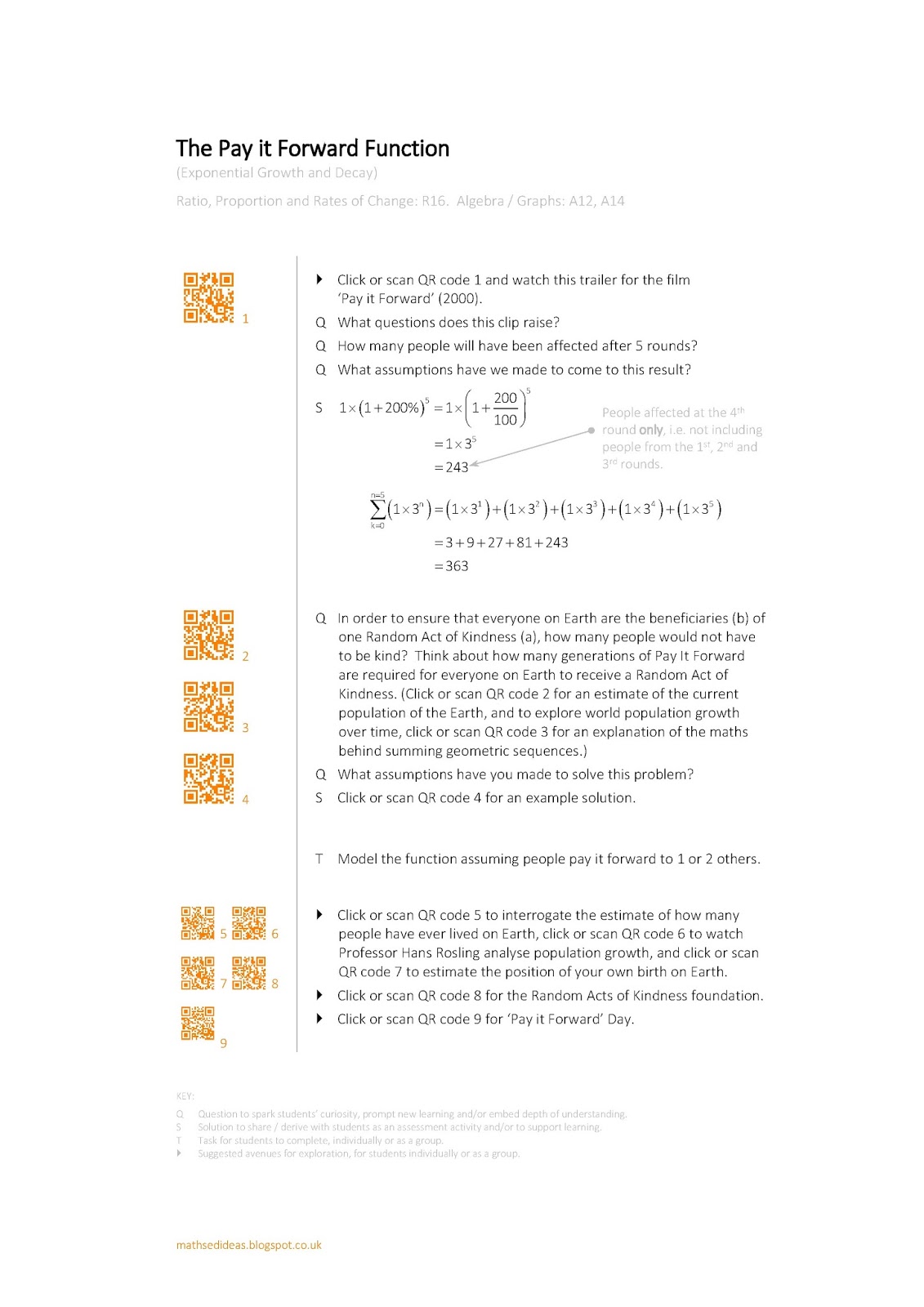This sequence of learning activities, designed with the development of students’ mathematical maturity in mind, is intended for use by secondary teachers to strengthen and deepen students’ understanding of compound interest, move into exponential growth and decay, and gently via iteration onto the exponential function.
Piggybacking learning on an interrogation of the bank balance of a 20th century pizza guy who finds himself in 31st century New New York after a cryonics lab accident (Futurama clip below), via a paper-folding journey across the observable universe and a mathematical modelling of the potentially memetic spread of Random Acts of Kindness, we end up at Euler’s number, e.
Four one-page outlines of learning activities are provided below (and as png images at the end of the post), each centred on a particular theme or hook — i.e. Futurama, Paper folding, Pay it Forward, Euler’s number — and each containing key questions and links to video and other online provocations, prompts, etc. Resources such as student practice tasks are also provided on each outline in the form of hyperlinks or QR codes to scan, to facilitate fuss-free downloads or projections onto a screen as desired. Note that all the following downloads are provided in pdf format, unless shown otherwise.
- Download 'The Futurama Function'
- Download 'The Paper Folding' function
- Download 'The Pay it Forward' function
- Download 'Euler's Number, e'
Each one-page outline does not necessarily correspond to one lesson — the sequence in full typically takes me 10-12 hours teaching time. Neither are the outlines intended for teachers to follow prescriptively; should a teacher use the ideas and resources presented here, they should of course adapt them in terms of where their own students' learning is currently situated, and where they are aiming to get to.
Work on the activities presented in this sequence focuses learning on the following aspects of the National Curriculum Mathematics Programmes of Study for key stage 4 in England:
- Ratio, proportion and rates of change: Solving and interpreting answers in growth and decay problems, including compound interest and work with general iterative processes.
- Algebra: Recognising, sketching and interpreting graphs of… exponential functions y = kx for positive values of k. Plotting and interpreting graphs (including… exponential graphs)… in real contexts









cfvvfgvdfgggvgfggf
ReplyDeleteشركة تنظيف خزانات
FGHNGCHYMJ
ReplyDeleteتسليك مجاري
شركة تسليك مجاري بالاحساء vwI5lvhq1E
ReplyDeleteشركة صيانة افران k4eBRfMeeZ
ReplyDeleteشركة مكافحة حشرات بالهفوف xH4FF29pjp
ReplyDeleteتسليك مجاري بالهفوف 0ljjOB9l2P
ReplyDeleteصيانه افران الغاز بمكه
ReplyDeletee0LmiFm1D
شركة تنظيف مساجد بالاحساء c5njwaag8L
ReplyDeleteشركة عزل مواسير المياه بالجبيل 6xqUYWJeoW
ReplyDeleteشركة عزل خزانات بالرس RVtPoGOMuX
ReplyDeleteشركة عزل اسطح بابها qm4IYmdnZl
ReplyDelete614097EB53
ReplyDeletetiktok takipçi yükseltme
صيانة افران بمكة 7nC8QJM7WF
ReplyDelete6973D4A850
ReplyDeletetwitter takipçi satın al
beğeni satın al
ig takipçi
güvenilir takipçi
güvenilir takipçi
3D86746869
ReplyDeleteinstagram takipçi alma güvenilir
twitter beğeni satın al
garantili takipçi
organik takipçi
güvenilir takipçi
D6C1D607BE
ReplyDeletemmorpg oyunlar
ucuz sms onay
turkcell mobil ödeme bozdurma
takipci satın alma
-
شركة تسليك مجاري
ReplyDeleteRHvYaFbM